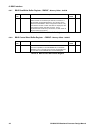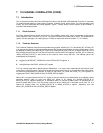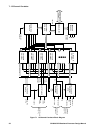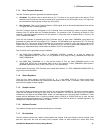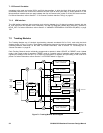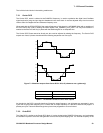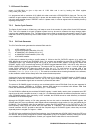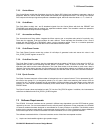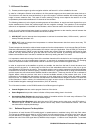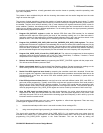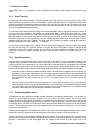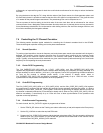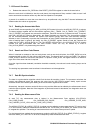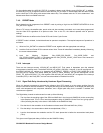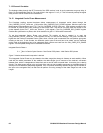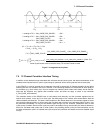7: 12-Channel Correlator
56 GP4020 GPS Baseband Processor Design Manual
2) Process pseudo-ranges to give the navigation solution and format it in a form suitable for the user.
In order for a Navigation Solution to be achieved, all of the pseudo-ranges must have exactly the same clock error.
This clock error can then be removed iteratively to give real ranges if sufficient satellites are tracked (three if the
height is known, otherwise four). This need for exact matching of timing errors explains the need for all of the
complicated synchronisation between all 12-channels of the correlator.
The following relates only to the signal processing aspects of the software, to acquire and track signals from up to
twelve satellites and to obtain the pseudo-ranges and the navigation message. The operation of the navigation
software is not dependent on the details of the correlator, and so does not need to be included in this data sheet.
A pair of on-chip interrupt time-base signals is provided to help implement a data transfer protocol between the
microprocessor and the 12-channel correlator at fixed time intervals:
1) ACCUM_INT. Used to interrupt the microprocessor to retrieve Accumulated data (1.023ms worth) - period of
interrupt normally less than 1ms.
2) MEAS_INT. Used to interrupt the microprocessor to retrieve Measurement data that occurs once every TIC
(approx. 100ms period).
These interrupts can be used to achieve instant response from the microprocessor via an Interrupt Service Routine.
Otherwise software-based polling will be needed; the choice is set by the application. If the ACCUM_INT interrupt is
used, and perhaps also if polling is used, the data transfer rate is about twice the correlation result rate for each
channel, so many transfers will not give new data. Bus use can be reduced by examining the status registers
before each transfer to see if new data is available and then only reading the data if it is useful.
It is important to note that the timing of each of the correlator channels will be locked to its own incoming signal and
not to each other or to the microprocessor interrupts, so new data is generated asynchronously. The sampling
instant of measurement data of all channels however is common to give a consistent navigation solution.
In order to acquire lock to the satellites as quickly as possible, the data from the last fix should be stored as a
starting point for the next fix. It is also useful to make use of the embedded real-time clock on the chip to give a
good estimate of GPS time for the next fix. The navigation solution can be used to measure clock drift and calculate
a correction for the clock to overcome ageing. The user's location (or a good estimate of it) along with the Almanac
and the correct time will indicate which satellites should be searched for. These may be used to find an estimate of
Doppler effects, while the previous clock error is the best available estimate of the present clock error. If this
information is not available then the receiver must scan a much wider range of values, which will greatly increase
the time to lock. The satellite Clock Correction and Ephemeris are needed for the navigation solution. If a recent set
of this information is held in memory, the calculations may begin as soon as lock is achieved and not need to wait
for the Satellite Navigation message re-transmission (18 to 36 seconds).
The 12-channel correlator on the GP4020 contains four different types of registers:
• Control Registers that are used to program functions of the device.
• Status Registers that provide a status indication of the process taking place in the device.
• Accumulated Data Registers that provide the results of correlation with the C/A code every millisecond. This
is the raw data used to acquire and track satellite signals.
• Measurement Data Registers which latch the carrier DCO phase, carrier cycle count, code DCO phase, 1
millisecond epoch, and the 20 millisecond epoch count at every 9.09 or 100 milliseconds interval. This is the
raw data used to compute pseudorange.
7.3.1
Software Sequence For Acquisition
The spectrum of each Navstar GPS satellite signal is spread-spectrum modulated using 1023 chip Gold codes.
This causes the satellite signals seen by a GPS receiver to be so weak that they are buried in the noise and can
only be detected by correlation. The GPS signal power at a GPS receiver antenna is typically approx. -130dBm,
whereas the noise in the GPS signal band (2.046MHz wide) is approx. -111dBm at room temperature. To correlate



